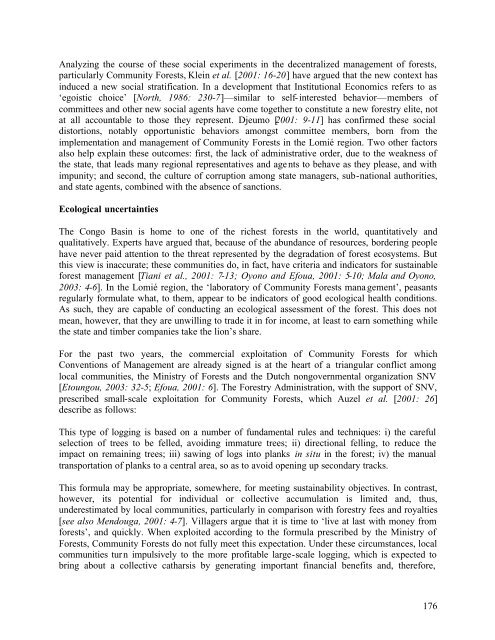chapter 10 social and organizational roots of ecological ...
chapter 10 social and organizational roots of ecological ...
chapter 10 social and organizational roots of ecological ...
You also want an ePaper? Increase the reach of your titles
YUMPU automatically turns print PDFs into web optimized ePapers that Google loves.
Analyzing the course <strong>of</strong> these <strong>social</strong> experiments in the decentralized management <strong>of</strong> forests,particularly Community Forests, Klein et al. [2001: 16-20] have argued that the new context hasinduced a new <strong>social</strong> stratification. In a development that Institutional Economics refers to as‘egoistic choice’ [North, 1986: 230-7]—similar to self-interested behavior—members <strong>of</strong>committees <strong>and</strong> other new <strong>social</strong> agents have come together to constitute a new forestry elite, notat all accountable to those they represent. Djeumo [2001: 9-11] has confirmed these <strong>social</strong>distortions, notably opportunistic behaviors amongst committee members, born from theimplementation <strong>and</strong> management <strong>of</strong> Community Forests in the Lomié region. Two other factorsalso help explain these outcomes: first, the lack <strong>of</strong> administrative order, due to the weakness <strong>of</strong>the state, that leads many regional representatives <strong>and</strong> agents to behave as they please, <strong>and</strong> withimpunity; <strong>and</strong> second, the culture <strong>of</strong> corruption among state managers, sub-national authorities,<strong>and</strong> state agents, combined with the absence <strong>of</strong> sanctions.Ecological uncertaintiesThe Congo Basin is home to one <strong>of</strong> the richest forests in the world, quantitatively <strong>and</strong>qualitatively. Experts have argued that, because <strong>of</strong> the abundance <strong>of</strong> resources, bordering peoplehave never paid attention to the threat represented by the degradation <strong>of</strong> forest ecosystems. Butthis view is inaccurate; these communities do, in fact, have criteria <strong>and</strong> indicators for sustainableforest management [Tiani et al., 2001: 7-13; Oyono <strong>and</strong> Efoua, 2001: 5-<strong>10</strong>; Mala <strong>and</strong> Oyono,2003: 4-6]. In the Lomié region, the ‘laboratory <strong>of</strong> Community Forests management’, peasantsregularly formulate what, to them, appear to be indicators <strong>of</strong> good <strong>ecological</strong> health conditions.As such, they are capable <strong>of</strong> conducting an <strong>ecological</strong> assessment <strong>of</strong> the forest. This does notmean, however, that they are unwilling to trade it in for income, at least to earn something whilethe state <strong>and</strong> timber companies take the lion’s share.For the past two years, the commercial exploitation <strong>of</strong> Community Forests for whichConventions <strong>of</strong> Management are already signed is at the heart <strong>of</strong> a triangular conflict amonglocal communities, the Ministry <strong>of</strong> Forests <strong>and</strong> the Dutch nongovernmental organization SNV[Etoungou, 2003: 32-5; Efoua, 2001: 6]. The Forestry Administration, with the support <strong>of</strong> SNV,prescribed small-scale exploitation for Community Forests, which Auzel et al. [2001: 26]describe as follows:This type <strong>of</strong> logging is based on a number <strong>of</strong> fundamental rules <strong>and</strong> techniques: i) the carefulselection <strong>of</strong> trees to be felled, avoiding immature trees; ii) directional felling, to reduce theimpact on remaining trees; iii) sawing <strong>of</strong> logs into planks in situ in the forest; iv) the manualtransportation <strong>of</strong> planks to a central area, so as to avoid opening up secondary tracks.This formula may be appropriate, somewhere, for meeting sustainability objectives. In contrast,however, its potential for individual or collective accumulation is limited <strong>and</strong>, thus,underestimated by local communities, particularly in comparison with forestry fees <strong>and</strong> royalties[see also Mendouga, 2001: 4-7]. Villagers argue that it is time to ‘live at last with money fromforests’, <strong>and</strong> quickly. When exploited according to the formula prescribed by the Ministry <strong>of</strong>Forests, Community Forests do not fully meet this expectation. Under these circumstances, localcommunities turn impulsively to the more pr<strong>of</strong>itable large-scale logging, which is expected tobring about a collective catharsis by generating important financial benefits <strong>and</strong>, therefore,176
















